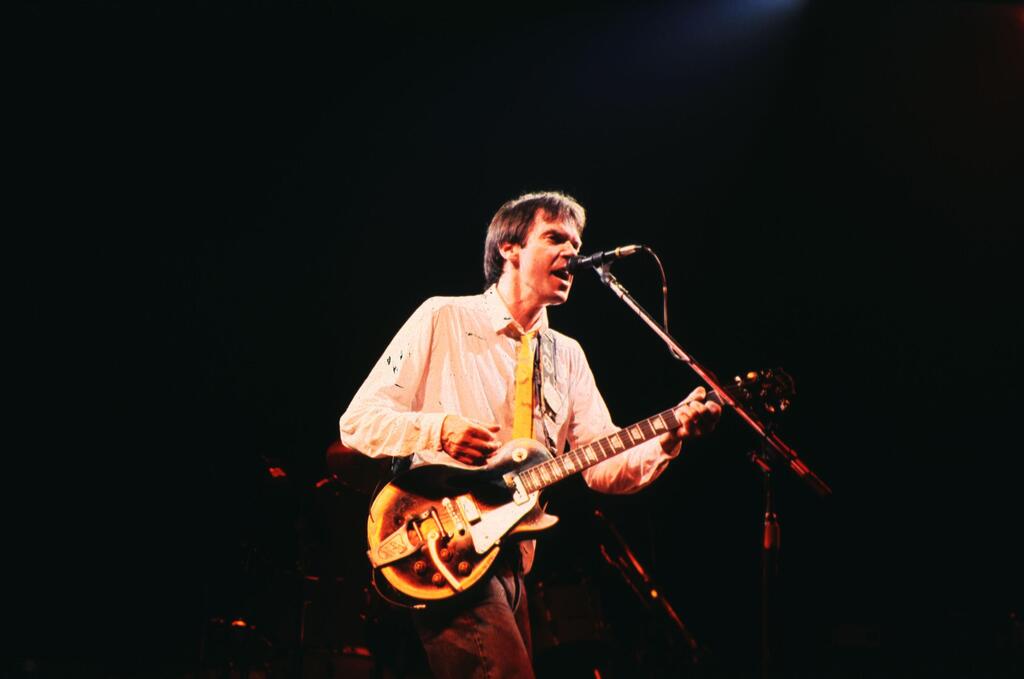In the late '70s, Neil Young famously stated, "It's better to burn out than to fade away." This memorable line made its appearance twice on the remarkable album he co-created with Crazy Horse in 1979 – "Rust Never Sleeps."
Read more:
The first time is in the soothing acoustic tones of "My My, Hey Hey (Out of the Blue)," which served as the album's gentle opener. Then, about half an hour later, it resurfaced in the electrifying and vigorous "Hey Hey, My My (Into the Black)," which marked the album's powerful conclusion. Interestingly, a quarter century later, these words would reappear in Kurt Cobain's farewell letter.
But unlike Nirvana's frontman, who chose to end his life at the age of 27, Neil Young is still very much a part of our musical landscape. He's no longer racing against the fear of fading away, a sentiment that often accompanies a series of setbacks. Instead, he's evolved into a methodical long-distance runner, adept at navigating artistic and personal valleys.
Beyond his iconic status, Neil Young remains a fearless artist with a touch of stubbornness, a quality that, even at the age of 78, propels him forward with a vitality reminiscent of his heyday in the '70s.
During that era, Neil Young was in a constant whirlwind of writing, recording and performing. Navigating the highs of success (which he experienced more than once) and grappling with the lows of failure (which were, unfortunately, more frequent), he was unafraid to switch between electric and acoustic sounds.
He even ventured into supergroups, only to part ways with a resounding door slam. Amid the trials of addiction, he mourned the loss of friends and musical collaborators, yet also took to the stage under the influence of cocaine on numerous occasions.
In those transformative years of his career, Young crafted love songs and endured heart-wrenching separations. The myriad personal and artistic upheavals he weathered not only birthed some of rock's most seminal albums, but also prompted him to shelve a number of projects that didn't resonate with him at the time.
These tumultuous experiences effectively charted the trajectory Young still follows. His musical style remains remarkably consistent, and his character and integrity have remained largely unchanged. Opting not to morph into a stylized superstar, he consciously chose to remain a steadfast worker in the realm of rock.
Even accomplished musicians, endowed with the gift of self-critique, occasionally cast aside songs and even entire albums that fail to meet their full satisfaction. These creations are rarely consigned to oblivion. In many instances, they find refuge within a drawer, waiting for the artist's heirs to decide when to capitalize on them.
Yet, in Neil Young's case, what he once set aside found its way into the light of day. The most remarkable illustration of this phenomenon emerges with the official release of Young's 44th album, "Chrome Dreams" – an elusive gem that has been considered the pinnacle of lost treasures in Young's extensive body of work, a symbolic unveiling after a staggering 46-year hiatus.
Adding an intriguing twist, in 2007, exactly 30 years following the original "Chrome Dreams" conception, Young unveiled the exquisite "Chrome Dreams II" album. This release served as a unique homage, akin to a musical genie's move, incorporating entirely different tracks.
Devotees of Neil Young's discography are well aware that tracking his recording journey is both a rewarding venture and one that exacts substantial investment from the audience, demanding their financial commitment and time. In today's musical landscape, there's a prevailing notion among industry insiders that the traditional album format is teetering on obsolescence, advocating for artists of all generations and genres to opt for the singles route.
However, Young is firmly rooted in the contrary stance. This belief not only applies to his retrospective material, which trickles out at an average pace of one or two releases annually – be they previously unheard or reimagined tracks – but extends to his ongoing songwriting endeavors. This perspective is evident in his recent albums, such as last year's "World Record" and the enchanting "Barn" from roughly two years prior, both in collaboration with Crazy Horse.
Neil Young faced the COVID-19 era with a blend of emotions. On one side of the spectrum, he engaged in an unwavering battle against pandemic deniers and vaccine skeptics, a campaign that led him to pull his music from Spotify's servers. As his tunes haven't made their way back onto the platform, fans will need to seek out the melodies of "Chrome Dreams" through alternative avenues.
On the flip side, he harnessed the newfound free time to meticulously organize his extensive archive of recordings. It's possible that amid the extended hours spent on his farm during lockdowns, Young came to realize that albums he once deemed incomplete now warranted a gentler assessment. With a fresh perspective and a kinder view of his younger self, Young embarked on a comprehensive journey of liberation.
Approximately three years ago, Young unveiled a box set that aimed to encapsulate his endeavors from that mid-decade period (another box set is slated for release next year). Additionally, he presented the album "Homegrown," a creation that he had originally crafted back in 1975. It's worth noting, incidentally, that Young's antics with "Homegrown" involved shelving it at the time in favor of another of his albums, the masterful "Tonight's the Night" (which also saw the light of day about two years beyond its intended release date).
Prior to Neil Young's decision to set aside "Homegrown," he embarked on the songwriting journey for his subsequent album, "Chrome Dreams," in December 1974. The creation process for this album extended well beyond two years – quite a substantial period in Young's creative timeline. Remarkably, during this span, he managed to release two additional albums, only for the "Chrome Dreams" project to eventually be put on hold.
Young, the mastermind behind the songs, introduced shifts in the lineup of musicians involved in the recordings and occasionally tinkered with arrangements. Several songs initially conceived for "Chrome Dreams," such as "Powderfinger," "Pocahontas," "Look Out for My Love" and "Like a Hurricane," eventually discovered a welcoming abode (albeit in altered versions) on other Young albums that graced the music scene in the latter half of the 1970s.
Conversely, tracks like "Too Far Gone" or "Stringman" had to bide their time extensively before making their debut. In numerous instances, their inclusion on those albums might have been appreciated, yet it didn't always feel seamlessly integrated. Consequently, even as the songs from the shelved album gradually emerged over the years, the legend surrounding "Chrome Dreams" blossomed with the passage of time.
Evidently, glimpses of the album were attainable, often through bootleg copies that circulated in the market, albeit with sound quality falling far short of the standards set by the creator, who always held a keen ear for his albums' sound. With the advent of streaming services, it became possible to artificially piece together the shelved album. However, the genuine and mythical essence of "Chrome Dreams" has now been officially unveiled. Let celebrations commence!
Reassessing the albums of an artist you've been following for decades can pose quite a challenge. However, as "Chrome Dreams" unfolds, it gradually positions itself as one of Neil Young's more accomplished works from the '70s, prompting a reevaluation of the Neil Young catalog. This album, undoubtedly ranking within the top ten of the prolific Canadian musician (bearing in mind that Young has released over 40 studio albums to date), masterfully strikes a balance between the two facets of Young's artistry during that era.
On one hand, the album showcases Young's prowess as a songwriter of astute ballads, a role that graced his initial triumphs with albums like "After the Gold Rush" and "Harvest." These qualities shine through in several acoustic and melodious tracks, delivered in intimate performances that transport listeners as if Young were right there in the room, strumming and singing.
On the other hand, the album also bears witness to Young's later determination in that decade to break away from the relatively mellow style that galvanized early acclaim. This drive is also reflected in notable albums such as "On the Beach," recorded alongside band members, and the somber "Tonight's The Night."
As previously mentioned, while the dozen songs presented here might not be new in the literal sense, experiencing them in their original form elicits a kind of revelation. Take, for instance, the delicate "Stringman," which was only unveiled during Young's somewhat underwhelming unplugged performance in the early '90s. Even a seemingly so-called minor track like "Hold Back the Tears," rendered here as a solo piece by Young, exudes a more organic feel compared to the familiar but less successful version that graced the 1977 album "American Stars 'n Bars."
This same uneven album earned the distinction of housing nearly half of the songs initially intended for "Chrome Dreams." It also features select tracks that feature contributions from Crazy Horse members, such as "Homegrown" and "Like a Hurricane." The latter, regarded as Young's triumphant return after a commercial slump in the mid-70s, receives an even more splendid treatment here, stretching close to eight and a half minutes of sheer musical bliss.
"Saden Delivery" serves as another example of how Young's straightforward guitar chords, accompanied and bolstered by the resounding power of Crazy Horse members, conjure some of the most exquisite sonic moments in the realm of music.
However, even after a joyful immersion into "Chrome Dreams", a lingering question persists: Just how unsure was Young during that time that he chose to tuck away an album that showcases him at the zenith of his prowess as both a songwriter and a performer? While theories may abound, it's perhaps more fitting to express gratitude towards Young for ultimately assembling the fragments of this enigmatic puzzle. The substantial entirety unveiled in this release is bound to captivate long-time listeners of Young who have patiently awaited its unveiling for decades.



